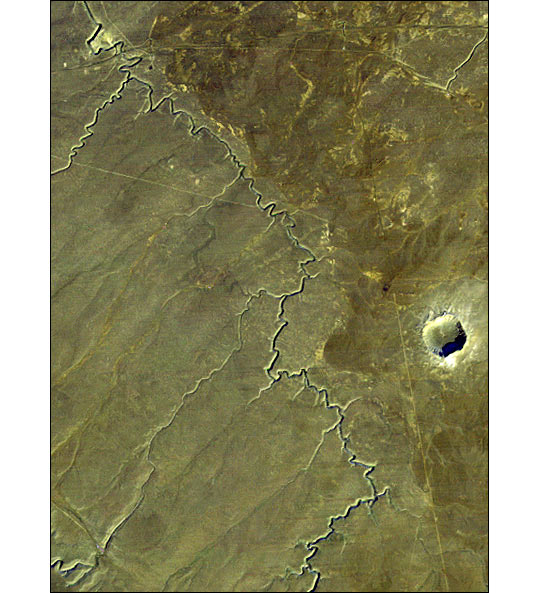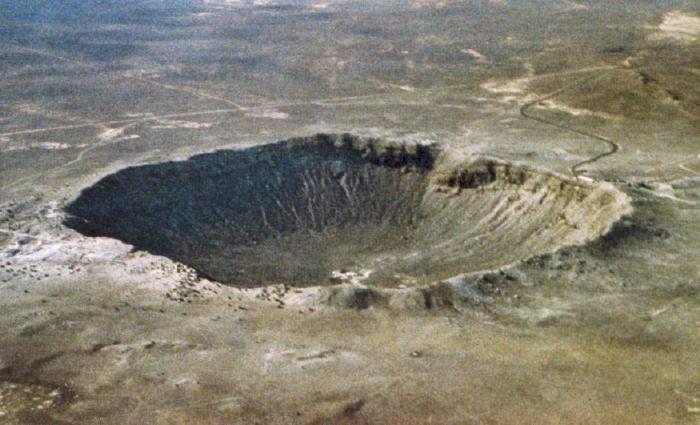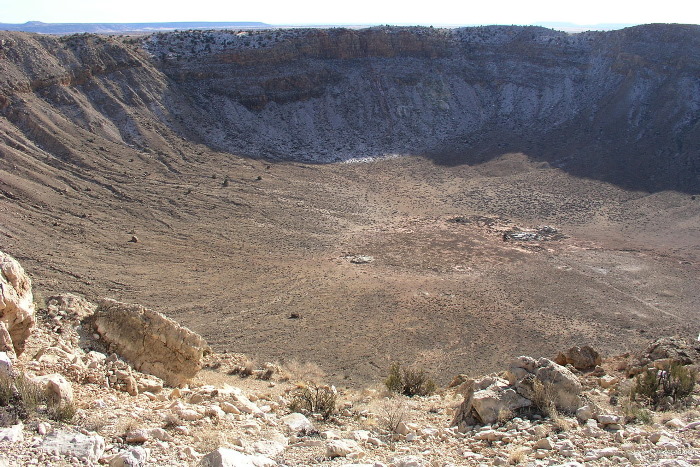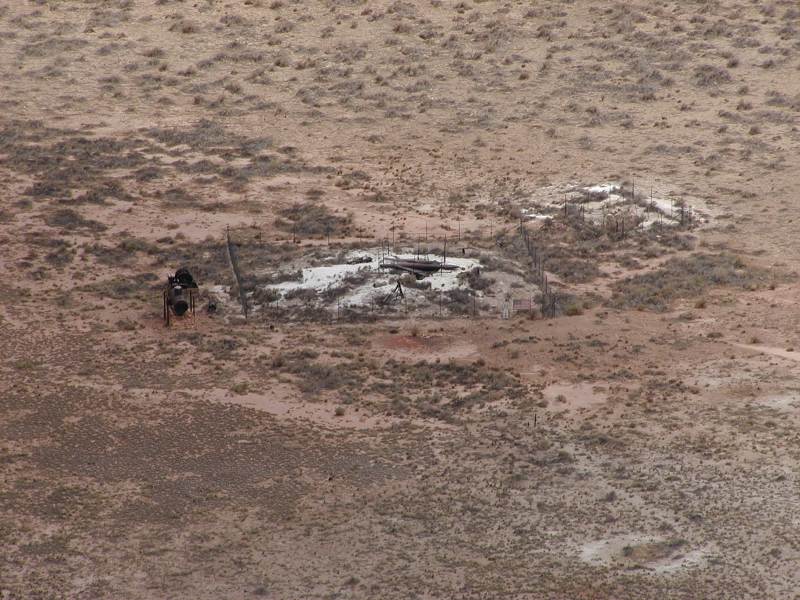|
The Enigmas on Earth |
||||
Excerpt: The Barringer Meteorite Crater (also known as "Meteor Crater") is a gigantic hole in the middle of the arid sandstone of the Arizona desert. A rim of smashed and jumbled boulders, some of them the size of small houses, rises 150 feet above the level of the surrounding plain. The crater itself is nearly a mile wide, and 570 feet deep. When Europeans first discovered the
crater, the plain
around it was covered with chunks of meteoritic iron,
over 30 tons of
it, scattered over an area 8 to 10 miles in
diameter.
Scientists now believe that the crater was created approximately 50,000 years ago. The meteorite which made it was composed almost entirely of nickel iron, suggesting that it may have originated in the interior of a small planet. It was 150 feet across, weighed roughly 300,000 tons, and was traveling at a speed of 28,600 miles per hour (12 kilometers per second) according to the most recent research. The explosion created by its impact was equal to 2.5 megatons of TNT, or about 150 times the force of the atomic bomb that destroyed Hiroshima. In 1946, meteorite collector Harvey H. Nininger analyzed the tiny metallic particles mixed into the soil around the crater, along with the small "bombs" of melted rock within it. He concluded that both types of particles were solidified droplets, which must have condensed from a cloud of rock and metal vaporized by the impact. Here, he believed, was proof that the crater was created by explosion. Based on new computer simulations of the event by Elisabetta Pierazzo, we now know that most of the meteorite was actually melted, and spread across the landscape in a very fine, nearly atomized mist of molten metal. - SOURCE |
||||
|
.
Meteor Crater near Winslow, Arizona, was the first impact crater to be recognized as such. In 1957, a young graduate student named Eugene Shoemaker (later of Comet Shoemaker Levy fame) convinced scientists that the iron fragments, a layer of broken rocks, and melted globs of soil were caused by a meteorite, not a volcano. Photo courtesy of John S. Shelton.
|
||||
|
.
Excerpt: March 10, 2005 Call it the mystery of the non melting meteorite: For decades scientists have wondered how a meteorite powerful enough to have made Arizona's Barringer Meteor Crater (pictured) could have left hardly any melted rock in its wake. Now a report in this week's issue of Nature looks to have closed the case. Prevailing wisdom had the meteorite speeding at 45,000 miles (72,000 kilometers) an hour when it hit. But H. Jay Melosh, of the University of Arizona, and Gareth Collins, of Imperial College London, used mathematical models to show that the space rock was likely hurtling at a mere 25,000 miles (43,000 kilometers) an hour. Why the slowdown? "The meteorite had probably been cracked from collisions in space," Melosh said in a statement. When the rock slammed into Earth's atmosphere some 50,000 years ago, half of it likely went to pieces. "As they came apart, atmospheric drag slowed them down, increasing the forces that crushed them so that they slowed and crumbled more." Now falling relatively gently, the approximately 65-foot-wide (20-meter-wide) chunk that remained intact crashed into the desert floor. It would have hit with the force of 150 Hiroshima bombs, creating, but not melting, the 0.75-mile-wide (1.2-kilometer-wide) pit we know today. —Ted Chamberlain - SOURCE |
||||
Excerpt: Meteor Crater in northern Arizona was the first impact crater to be recognized on Earth. It was excavated about 50,000 years ago when a nickel iron meteorite struck and blasted a hole three quarters of a mile (1.2 kilometers) across. Past estimates by scientists generally held that the object struck at 9 to 12 miles (15 to 20 km) per second. Now, however, two planetary scientists calculate that the crater came from a somewhat slower impact, about 7 to 8 miles (12 km) per second. In addition, say Jay Melosh of the University of Arizona and Gareth Collins of Imperial College, London, the impacting body broke up in the atmosphere and hit the ground in pieces. This, they say, explains why relatively little impact melted rock has been discovered at the crater. Melosh and Collins also point to the large numbers of small, un-molten iron meteorite fragments found near the crater. Their computer model for the impact predicts a shock wave just ahead of the incoming body would start breaking it apart at an altitude of about 9 miles (14 km). By the time the meteorite had fallen to an altitude of 3 miles (5 km), they say, it was a pancake shaped swarm roughly 700 feet (200 meters) across. Writing in Nature (March 10, 2005), Melosh and Collins say, "The projectile would have been greatly slowed by the atmosphere and would have struck as a dispersed cluster of iron fragments." When it struck, however, their calculations suggest one fragment probably contained about half the original object's mass. The amount of impact melt at Meteor Crater has been disputed by geologists. Some have explained the apparent lack as due to weathering during the 50,000 years since the impact. Others have suggested some impact melt was destroyed in the impact explosion. Asked how the discovery of more impact melt at the crater would affect their finding, Melosh told Astronomy, "That would point to a lesser amount of fragmentation" in the impacting body. Meteor Crater lies between Flagstaff and Winslow, Arizona, about 6 miles (10 km) south of Interstate 40. - SOURCE |
||||
|
. This HRC image,
acquired on 23 January 2004, shows Meteor
Crater, also known as the Barringer Meteorite
Crater, located near Winslow,
Arizona. The 1.186 km diameter crater is
approximately 180 meters deep
and is surrounded by a rim of smashed and jumbled
boulders, some as big
as houses. The shadow casting structure visible on
the north side of the
Crater is the Visitor's Center. (Click Image for
Full Size)
|
||||
| FAIR USE NOTICE: This page contains copyrighted material the use of which has not been specifically authorized by the copyright owner. Pegasus Research Consortium distributes this material without profit to those who have expressed a prior interest in receiving the included information for research and educational purposes. We believe this constitutes a fair use of any such copyrighted material as provided for in 17 U.S.C § 107. If you wish to use copyrighted material from this site for purposes of your own that go beyond fair use, you must obtain permission from the copyright owner. | ||||
|
|







